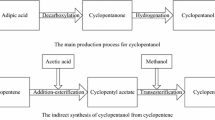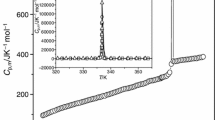Abstract
2-Methoxycyclohexanol is synthesized through an alcoholysis reaction of cyclohexene oxide and methanol with Ag2CsPW12O40 as catalyst. The elemental analyzer, FT-IR, GC, and NMR are used to analyze and confirm elements, functional groups, purity, and molecular structure of 2-methoxycyclohexanol. The equation between the specific heat capacity (C p) and the temperature from 280 to 340 K is fitted by the results of differential scanning calorimeter to examine 2-methoxycyclohexanol. Bomb calorimeter is introduced to determine the standard enthalpy change of combustion of 2-methoxycyclohexanol (− 3938.6 ± 2.0 kJ mol−1). The standard enthalpy of formation has been calculated as − 816.88 ± 2.21 kJ mol−1, based on Hess’s law. These basic thermodynamic parameters are deemed to facilitate the exploitation of new production route of 2-methoxycyclohexanol.





Similar content being viewed by others
References
Fuganti C, Grasselli P, Mendozza M, Servi S, Zucchi G. Microbially-aided preparation of (S)-2-methoxycyclohexanone key intermediate in the synthesis of sanfetrinem. Tetrahedron. 1997;53(7):2617–24. https://doi.org/10.1016/S0040-4020(96)01152-0.
Iranpoor N, Mohammadpour Baltork I. 2,3-Dichloro-5,6-dicyano-p-benzoquinone, an efficient, mild, neutral and highly regioselective catalyst for alcoholysis of epoxides. Tetrahedron Lett. 1990;31(5):735–8. https://doi.org/10.1016/S0040-4039(00)94616-1.
Yoo DW, Yoo SK, Kim C, Lee JK. A novel mononuclear Fe(III) mono(terpyridine) complex having labile solvent ligands and its catalytic activity. J Chem Soc Dalton Trans. 2002;21(21):3931–2.
Lakshmi Kantam M, Aziz K, Jeyalakshmi K, Likhar PR. Bis(cyclopentadienyl)zirconium dichloride: an efficient catalyst for highly selective formation of β-alkoxy alcohols via ring opening of 1,2-epoxides with alcohols. Catal Lett. 2003;89(1):95–7. https://doi.org/10.1023/a:1024727727995.
Jiang D, Mallat T, Krumeich F, Baiker A. Copper-based metal-organic framework for the facile ring-opening of epoxides. J Catal. 2008;257(2):390–5.
Pourali AR, Ghayeni S, Afghahi F. ChemInform abstract: efficient and regioselective ring-opening of epoxides with alcohols and sodium azide by using catalytic amounts of GaCl3/polyvinylpyrrolidone. Bull Korean Chem Soc. 2013;34(6):1741–4.
Kawamorita S, Hamasaka G, Ohmiya H, Hara K, Fukuoka A, Sawamura M. Hydrogenation of hindered ketones catalyzed by a silica-supported compact phosphine–Rh system. Org Lett. 2008;10(20):4697–700.
Pilař R, Honcová P, Koštál P, Sádovská G, Svoboda L. Modified stepwise method for determining heat capacity by DSC. J Therm Anal Calorim. 2014;118(1):485–91.
Pak J, Qiu W, Pyda M, Nowak-Pyda E, Wunderlich B. Can one measure precise heat capacities with DSC or TMDSC? J Therm Anal Calorim. 2005;82(3):565–74. https://doi.org/10.1007/s10973-005-0935-8.
Piekarski H, Tkaczyk M, Wasiak M. Heat capacity of aqueous 2-(2-hexyloxyethoxy)ethanol solutions by DSC. J Therm Anal Calorim. 2005;82(3):711–8. https://doi.org/10.1007/s10973-005-0954-5.
Gotcu-Freis P, Cupid DM, Rohde M, Seifert HJ. New experimental heat capacity and enthalpy of formation of lithium cobalt oxide. J Chem Thermodyn. 2015;84:118–27. https://doi.org/10.1016/j.jct.2014.12.007.
ASTM norm E1269-11. Standard test method for determining specific heat capacity by differential scanning calorimetry, Pennsylvania, ASTM International. http://www.astm.org/Standards/E1269.htm.
Han XW, Zhou CR, Shi XH. Determination of specific heat capacity and standard molar combustion enthalpy of taurine by DSC. J Therm Anal Calorim. 2012;109(1):441–6. https://doi.org/10.1007/s10973-011-1670-y.
Maksimuk Y, Ponomarev D, Sushkova A, Krouk V, Vasarenko I, Antonava Z. Standard molar enthalpy of formation of vanillin. J Therm Anal Calorim. 2017;. https://doi.org/10.1007/s10973-017-6651-3.
Xu F, Sun LX, Tan ZC, Liang JG, Di YY, Tian QF, et al. Low-temperature heat capacities and standard molar enthalpy of formation of aspirin. J Therm Anal Calorim. 2004;76(2):481–9.
Di YY, Tan ZC, Sun XH, Wang MH, Xu F, Liu YF, et al. Low-temperature heat capacity and standard molar enthalpy of formation of 9-fluorenemethanol (C14H12O). J Chem Thermodyn. 2004;36(2):79–86. https://doi.org/10.1016/j.jct.2003.08.017.
Shi Q, Tan ZC, Tong B, Di YY, Zhang ZH, Zeng JL, et al. Low-temperature heat capacity and standard molar enthalpy of formation of crystalline 2-pyridinealdoxime (C6H6N2O). J Chem Thermodyn. 2007;39(5):817–21. https://doi.org/10.1016/j.jct.2006.09.016.
Sabbah R, Xu WA, Chickos JS, Leitão MLP, Roux MV, Torres LA. Reference materials for calorimetry and differential thermal analysis. Thermochim Acta. 1999;331(2):93–204. https://doi.org/10.1016/S0040-6031(99)00009-X.
Ditmars DA, Ishihara S, Chang SS, Bernstein G, West ED. Enthalpy and heat-capacity standard reference material: synthetic sapphire (alpha-Al2O3) from 10 to 2250 K. J Res Natl Bur Stand. 1982;87(2):159.
Wang M, Lei H, Hou Z, Wang S. Heat capacities and standard molar enthalpy of formation of pyrimethanil maleic salt and pyrimethanil fumaric salt. J Therm Anal Calorim. 2013;114(1):313–9. https://doi.org/10.1007/s10973-012-2853-x.
Yu HG, Tan ZC, Liu Y, Lan XZ, Xu F, Huang XM, et al. Standard enthalpy of formation and heat capacities of 3,5-di-tert-butylsalicylic acid. Thermochim Acta. 2003;404(1–2):89–95. https://doi.org/10.1016/S0040-6031(03)00084-4.
Certificate of Analysis Standard Reference Material 39j Benzoic Acid Calorimetric Standard. NBS W, 1995.
Li HC, Fu B. Handbook of practical chemistry. Beijing: Chemical Industry Press; 2007.
Meng QY, Xu D, Di YY, Gao ZF, Dou JM. Low-temperature heat capacities and thermodynamic properties of ethyl 4-dimethylaminobenzoate (C11H15NO2). J Therm Anal Calorim. 2015;119(3):1923–30. https://doi.org/10.1007/s10973-014-4293-2.
Qiang GL, Xu L, Bin D, Xu WY. Thermochemical studies on the thioproline. J Therm Anal Calorim. 2006;85(3):585–7. https://doi.org/10.1007/s10973-006-7630-2.
Cox JD, Wagman DD, Medvedev VA. CODATA key values for thermodynamics. New York: Hemisphere Publishing Corp.; 1989.
Acknowledgements
This work was financially supported by the “Iconic Innovation Project” plan of Henan Institute of Science and Technology (No. 2015BZ02), and the Henan Innovation Foundation for Higher Education (No. 2012HASTIT037).
Author information
Authors and Affiliations
Corresponding author
Rights and permissions
About this article
Cite this article
Feng, J., Shang, Y. & Zhang, Y. Research on synthesis and thermodynamic properties of 2-methoxycyclohexanol. J Therm Anal Calorim 131, 2197–2203 (2018). https://doi.org/10.1007/s10973-017-6784-4
Received:
Accepted:
Published:
Issue Date:
DOI: https://doi.org/10.1007/s10973-017-6784-4




